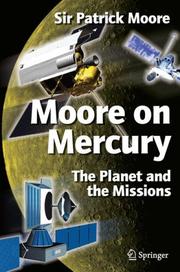| Listing 1 - 2 of 2 |
Sort by
|

ISBN: 0231039964 Year: 1977 Publisher: New York (N.Y.): Columbia university press
Abstract | Keywords | Export | Availability | Bookmark
 Loading...
Loading...Choose an application
- Reference Manager
- EndNote
- RefWorks (Direct export to RefWorks)

ISBN: 9781846287602 1846282578 9781846282577 184628760X Year: 2007 Publisher: Berlin ; London : Springer,
Abstract | Keywords | Export | Availability | Bookmark
 Loading...
Loading...Choose an application
- Reference Manager
- EndNote
- RefWorks (Direct export to RefWorks)
Mercury is one of the more difficult objects for amateur astronomers to observe because of its close proximity to the Sun. For the same reason, it is also one of the most fascinating and strange planets. Mercury is not much larger that our Moon, but orbits the Sun at an average distance of only 58 million km, compared to the Earth’s 150 million km. On its sunlit side, Mercury’s surface temperature can exceed 450C while the night side freezes at –180C. Amateur astronomers can see Mercury and its ever-changing phases all year, and sometimes watch it transit the Sun – the next transit is in November 2006, followed by one in May 2016. In his inimitable, easy-going style, Patrick Moore describes Mercury, the professional astronomers who have observed it over the centuries, amateur observations, and the past, present and future space missions to this extraordinary world.
Popular Science. --- Popular Science in Astronomy. --- Astronomy, Observations and Techniques. --- Planetology. --- Science (General). --- Astronomy. --- Planétologie --- Astronomie --- Mercury (Planet). --- Mercury probes. --- Space flight to Mercury. --- Space flight to Mercury --- Mercury probes --- Mechanical Engineering --- Astronomy & Astrophysics --- Physical Sciences & Mathematics --- Engineering & Applied Sciences --- Astrophysics --- Astronomy - General --- Aeronautics Engineering & Astronautics --- Mercury (Planet) --- Flight to Mercury --- Popular works. --- Observations, Astronomical. --- Astronomy --- Observations. --- Space probes --- Interplanetary voyages --- Planetary sciences --- Planetology --- Astronomy—Observations. --- Astronomical observations --- Observations, Astronomical
| Listing 1 - 2 of 2 |
Sort by
|

 Search
Search Feedback
Feedback About UniCat
About UniCat  Help
Help News
News